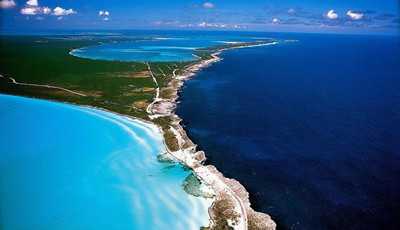Imagine paradise.
想象下天堂的模样。
Now imagine the Bahamas.
现在想象一下巴哈马群岛。
Hard to tell the difference.
你很难讲出它的独特之处。
The island nation boasts brilliant white sands, clear waters and vibrant coral reefs.
这个群岛拥有洁白无瑕的沙滩,清澈透明的海水及充满生机的珊瑚礁。
The waters of the Bahamas are so clear because they're low in nutrients.
巴哈马的海水如此清澈的原因在于其盐分缺乏营养。
They're therefore relatively free of the microscopic life that turns richer waters murky—and is normally associated with the deposition of calcium carbonate.
这个岛屿相对的摆脱了微生物的影响,而就是这些小东西使得营养较丰富的海水变得浑浊,通常原因在于和碳酸钙沉淀物有关。
So how did the reefs come to be?
所以礁石是怎样形成的呢?

A group of scientists argue that dust from across the Atlantic in Africa may have initiated the process.
一些科学家认为可能是非洲的灰尘横跨大西洋来到这里造就了这一进程。
Dust blows off the Sahara today, reaching all the way to the Americas.
灰尘从现在的撒哈拉沙漠被吹过来,一路旅程到达美洲。
Fertilized by the dust, cyanobacteria can then grow and pull carbon dioxide out of the water.
蓝细菌经过这些灰尘的洗礼就可以生长并把水中的二氧化碳排到外面。
That activity in turn causes calcium carbonate to precipitate, an event known as a whiting.
这一过程反过来也引发了被称为whiting反应的碳酸钙沉淀形成。
And the cyanobacteria also fix nitrogen from the atmosphere, helping other microorganisms to thrive.
而且蓝细菌也可以调整空气中的氮含量,帮助其他微生物茁壮成长。
This may have been going on for a very long time.
这个过程可能需要很长一段时间。
Enough of such cyanobacterial work over enough time and eventually you get the Bahamas, built out of calcium carbonate.
需要足够多的这种蓝细菌在长时间里共同参与,最终才会有这个用碳酸钙建造起来的巴哈马群岛。
At least that's what's suggested by trace elements in Bahama sediments.
至少这是通过查探巴哈马群岛的沉淀物之后而提出的。
The hypothesis is in the journal Geology.
这一假设已经在《地质学》杂志上发表。
Fertilizing similarly nutrient poor waters might help reduce rising levels of carbon dioxide that are causing uncomfortable global warming.
类似的,施肥少的水域可能会有助于减少一直在不断上涨的二氧化碳浓度,而这种物质过多会我们感觉不舒服,引发全球变暖。
And maybe we'd get some pretty nice islands out of the deal—eventually.
也许最终我们可以利用这种方法营造一些非常美丽的岛屿。











